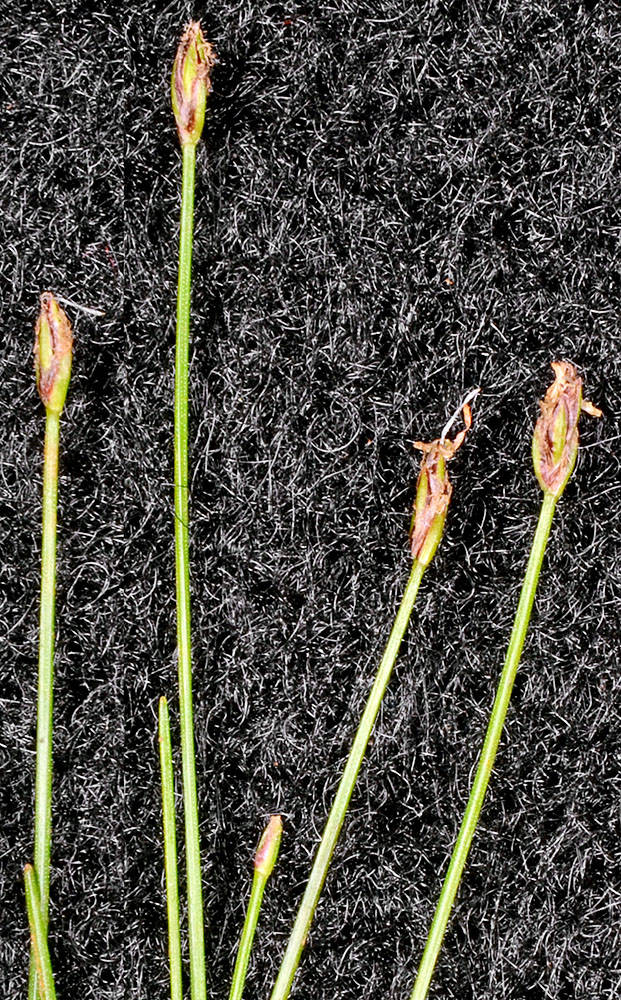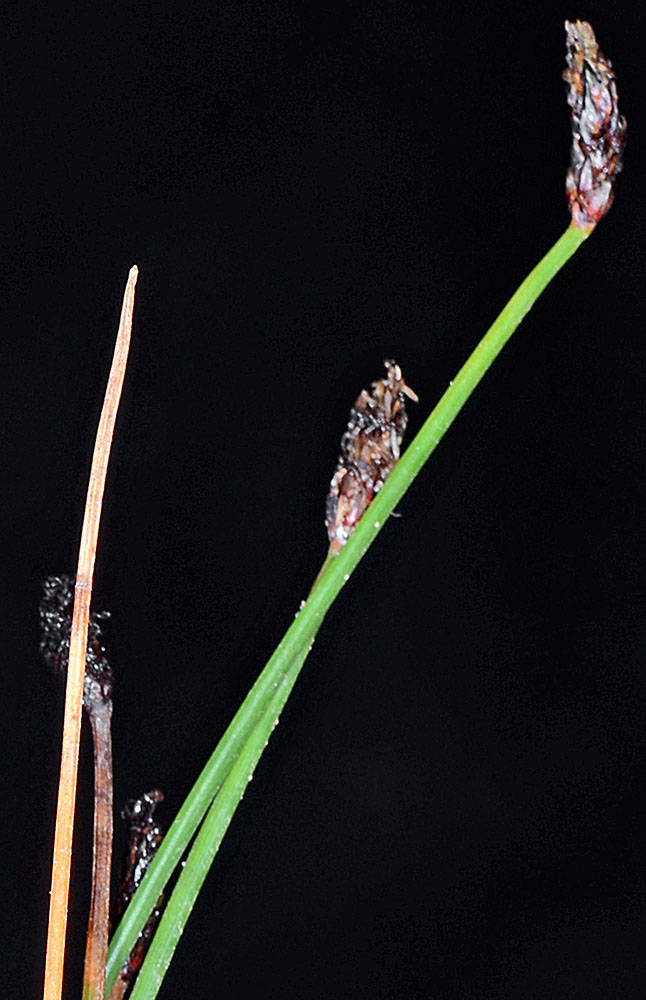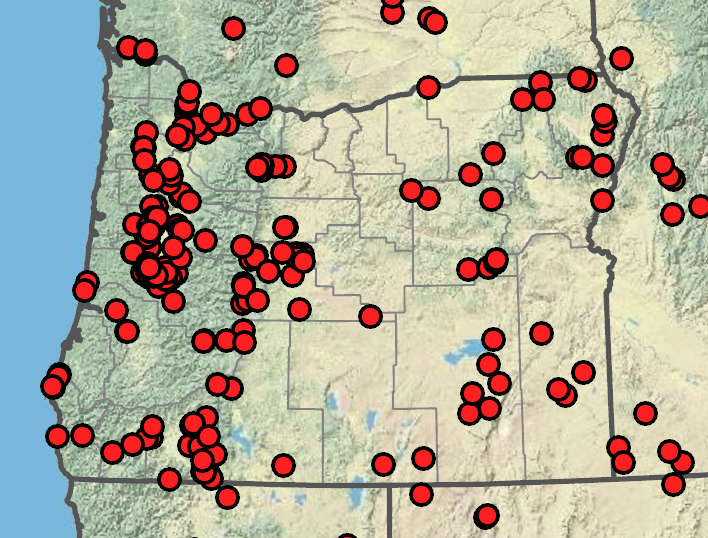Eleocharis acicularis
Eleocharis macrostachya
needle spikerush
confusing spikerush, pale spikerush
sometimes arching; terete to sometimes distinctly compressed, 1–60 cm × 0.2–0.5(0.7) mm.
terete to markedly compressed; to 3 times wider than thick, 10–100 cm × 0.5–2.5(3.5) mm.
2–8 × 1–2 mm; floral scales 4–25, 4–6 per mm of rachilla, 1.5–2.5(3.5) × 1–1.5 mm;
apex blunt to acute.
narrowly lanceoloid to ovoid, 5–40 × 2–5 mm;
proximal scale clasping (6)75(100)% of culm usually variably in same plant, subproximal scale usually empty in some spikes and subtending a flower in other spikes in the same clone; floral scales 30–80, 3–5 per mm of rachilla, 2.5–5.5 × 1.5–2.5 mm.
perianth bristles mostly absent, uncommonly 2–4; shorter than to equaling achene;
anthers 0.7–1.5 mm;
stigmas 3.
perianth bristles 4(5), sometimes rudimentary or absent; much shorter than achene to equaling tubercle;
stamens 2(3);
anthers 1.3–2.7 mm;
stigmas 2.
with angles plus about 8–12 obscure to prominent longitudinal ridges, narrowly to broadly obovoid to obpyriform, 0.7–1.1 × 0.35–0.6 mm; fine horizontal ridges 30–60, clearly evident to crowded and obscure; spaces between trabeculae sometimes translucent.
biconvex to plano-convex, 1.1–1.9 × 0.8–1.5 mm.
often splitting;
apex rounded (to acute).
persistent;
apex truncate to obtuse; tooth sometimes present on some or all culms, 0.1–0.6(1) mm.
pyramidal to much depressed; (0.05)0.1–0.2 × 0.15– 0.25 mm.
pyramidal; as high as or sometimes much higher than wide, 0.35–0.7 × 0.25–0.7 mm.
=20.
=18, 19, 38.
Eleocharis acicularis
Eleocharis macrostachya
Ponds, shallow wetlands, and exposed shorelines and mudflats, vernal pools, and other, often disturbed wetlands. 0–2300 m. All ecoregions except Col. CA, ID, NV, WA; north to AK, east to Greenland and GA, south to South America; Australia, Eurasia. Native.
Plants of this species frequently grow as submerged or floating mats that do not flower. These plants differ from typical E. acicularis in having terete, smooth, soft, translucent culms with conspicuous partitions between the air cavities. Such plants are difficult to identify and can be confused with Schoenoplectus subterminalis. Eleocharis acicularis is highly variable, but much of the variation is probably environmental, dependent particularly on water depth. As a result of this plasticity, recognition of any of the described varieties is likely unwarranted. Eleocharis bella is similar but annual, cespitose, only occasionally produces rhizomes and has smaller floral scales, anthers, and achenes.
Fresh to slightly brackish or alkaline marshes, lake shores, stream beds, vernal pools, deflation plains, and wet meadows. 0–1800 m. BR, BW, Col, CR, ECas, Est, Lava, Owy, Sisk, WV. CA, ID, NV, WA; north to AK, east to Quebec and MS, south to Mexico; South America. Native.
Eleocharis macrostachya is a diploid-polyploid complex consisting (at least in part) of populations that originated as hybrids of E. palustris with E. erythropoda and E. uniglumis. As a result, E. macrostachya is one of the most variable species in the genus. Plants vary from short, narrow-culmed plants resembling E. erythropoda to fairly robust individuals resembling E. palustris. The extent to which the proximal scale clasps the culm is usually greater than in E. palustris and often varies within a clone, as does the present or absence of a flower in the subproximal scale. Strictly coastal individuals have shiny dark chestnut brown or blackish achenes with brownish midribs. The proximal scales usually clasp 95–100% of the culm, and the subproximal scales usually subtend flowers. The culms are tough and sometimes arching. These plants can be referred to as E. macrostachya variant C (coastal form) or E. macrostachya tending toward E. uniglumis, according to Smith et al. (2002). Most inland Oregon plants are referred to as E. m. variant B.
Barbara Wilson, Richard Brainerd, Nick Otting
Barbara Wilson, Richard Brainerd, Nick Otting
- Local floras:
BC,
CA,
OR,
WA
- Local Web sites:
CalFlora,
CalPhotos,
Flora NW,
PNW Herbaria
WildflowerSearch
iNaturalist (observations)
USDA Plants Database
- LBJ Wildflower Center
- SEINet
- Plants of the World Online
- Encyclopedia of Life
- Wikipedia
- Google Image Search
- Local floras:
BC,
CA,
OR,
WA
- Local Web sites:
CalFlora,
CalPhotos,
Flora NW,
PNW Herbaria
WildflowerSearch
iNaturalist (observations)
USDA Plants Database
- LBJ Wildflower Center
- SEINet
- Plants of the World Online
- Encyclopedia of Life
- Wikipedia
- Google Image Search





